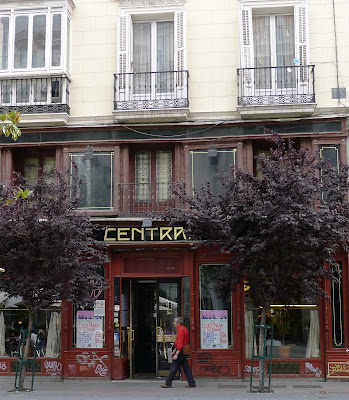Today we walked from Plaza Sol to visit Paseo del Prado and the Musée national du Prado, one of the world's greatest collections of art. The two artists who are best represented in the Prado are Velázquez and Goya. The Museum has almost 50 paintings by the former, mostly from the Spanish Royal Collection. They include almost all the artist's major compositions. The Museo del Prado has the largest collection of Spanish painting in the world, numbering more than 4,800 paintings and dating from the Romanesque period to the 19th century.
| From Wikipedia, the free encyclopedia |
My friend and traveling companion, Tom, jokingly warned me ahead of our entrance, “Now, what you're really going to see, is paintings of unhealthy looking rich people, plates of rotting food, naked people being vanquished and clothed people having religious fits.….............” His indefatigable, never-ending, dry humor was to set the tone for our entire time together in Spain!
| From Wikipedia, the free encyclopedia |
The Paseo del Prado is one of the main boulevards in Madrid, Spain and is one of the oldest historical urban areas in Madrid. It was declared Bien de Interés Cultural (BIC). The Paseo and its garden runs north-south between the Plaza de Cibeles and the Plaza del Emperador Carlos V (also known as Plaza de Atocha), with the Plaza de Cánovas del Castillo (the location of the Fuente de Neptuno, and of the Ritz and Palace five-star hotels) lying approximately in the middle. The Paseo del Prado forms the southern end of the city's central axis (which continues to the north of Cibeles as the Paseo de Recoletos, and further north as the Paseo de la Castellana).
| From Wikipedia, the free encyclopedia |
This densely tree-lined, wide and centric avenue is a landmark for the city residents and the location of important cultural and tourist spots in the city, including the so-called Golden Triangle of Art, which encompasses three museums: the Prado Museum (with highlights such as Diego Velázquez's Las Meninas and Francisco de Goya's La maja vestida and La maja desnuda), the Thyssen-Bornemisza Museum (housing a collection that spans eight centuries of European painting), and the Reina Sofia Museum (where Pablo Picasso's Guernica hangs, among a collection of 20th century art). In the vicinity are located the Parque del Buen Retiro and the Casón del Buen Retiro (hosting the 19th-century collection of the Prado Museum), as well as the headquarters of the Real Academia Española (the Spanish language academy), Madrid's stock exchange, and the Congreso de los Diputados (the national congress).
The Paseo del Prado boulevard includes several monuments and enclosures that are of historical and artistic interest, erected in the eighteenth century for the Hall of Prado urban project. Numerous ornamental and landscaping grounds were constructed for this project. The highlights of this project include the Villanueva Building, headquarters of the Prado Museum, the Royal Botanical Gardens and the sculptural water fountains of Neptune, Cibeles and Apollo.
From "Hanging Art" to 'Performing Art"
 |
| Cafe Central - One of Madrid's great spots for Jazz |
Last night, after the paseo, we re-visited perhaps the most famous jazz club in Madrid, Cafe El Central. We were there two nights prior, packed into the 200 year old taverna with adoring fans of Eliseo Parra, a jazz ensemble of absolutely incredible talent. Eliseo Parra is internationally known for his original variations of compositions based on the traditional Basque music of Northern España.
Towards the end of their concert two nights ago, during a very “up-beat” Basque folk-dance, La Señora reached out from her adjacent table, took my hand and coaxed me into the only space with enough room to spin and fast foot. The audience was clapping rhtymetically with the jazz combo and I just let the moment take me away in the revelry.
Towards the end of their concert two nights ago, during a very “up-beat” Basque folk-dance, La Señora reached out from her adjacent table, took my hand and coaxed me into the only space with enough room to spin and fast foot. The audience was clapping rhtymetically with the jazz combo and I just let the moment take me away in the revelry.
We retired about 8-10 minutes later, wet from perspiration and surrounded by the younger patrons, on their feet, clapping and encouraging Eliseo Parra to continue until we finally collapsed into our chairs amidst their laughter and applause. My friend, Peter, would have been dynamite in this place, with his love of classical dance, music and his irrepressible, infectious personality!
Really not sure what came over me...but when you're wrinkled and have lots of white hair, you can get away with a lot! Tom chopped me off, so-to-speak; no more Sangria for the rest of the night lest I make myself a greater fool!
 |
| Casa Toni - Madrid |
Ahhhhhh...but I digress, and now it's that time...paseo...we'll find the perfect table in a plaza surrounded by Madrid's grand architecture of the 18th and 19th century. With tinto verano in hand, we'll watch the passing by of contemporary Spain until it's time to head for late evening tapas at Casa Toni's or the Alhambra.
No comments:
Post a Comment